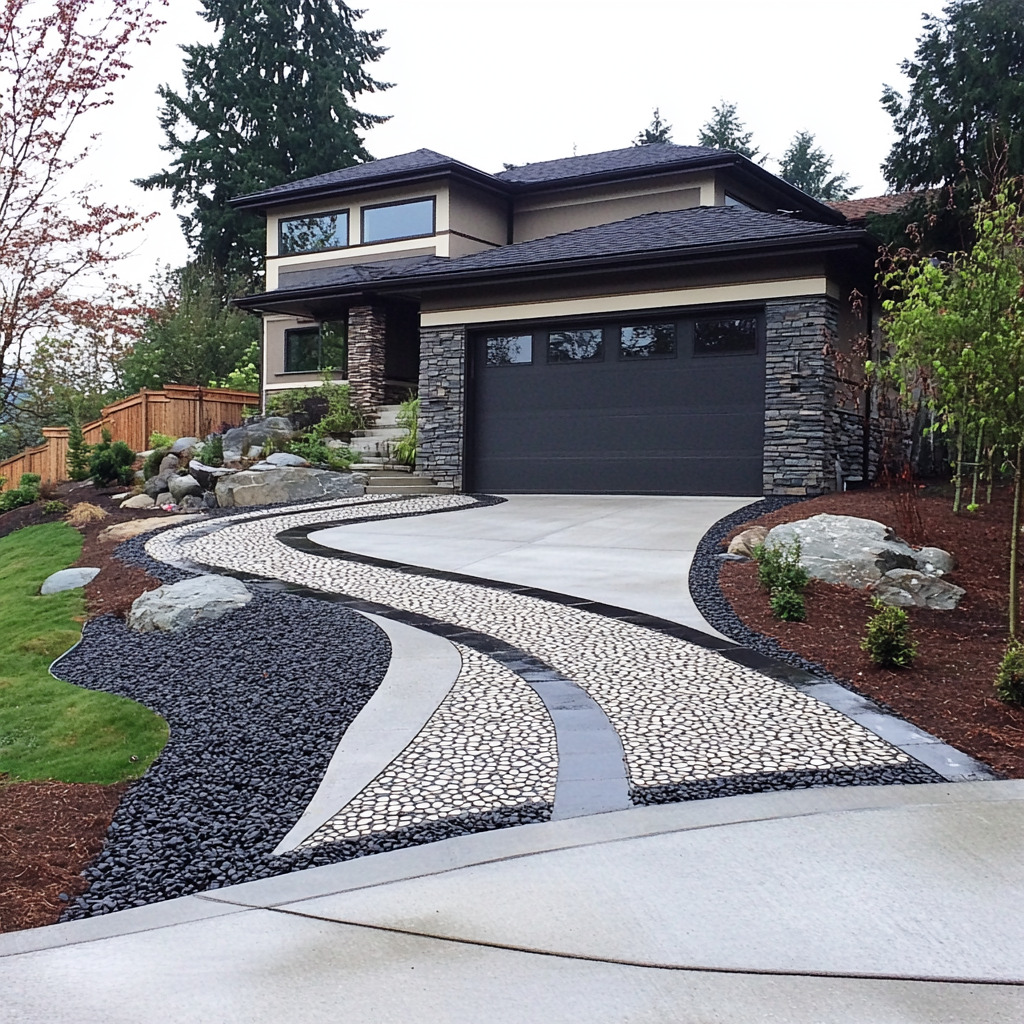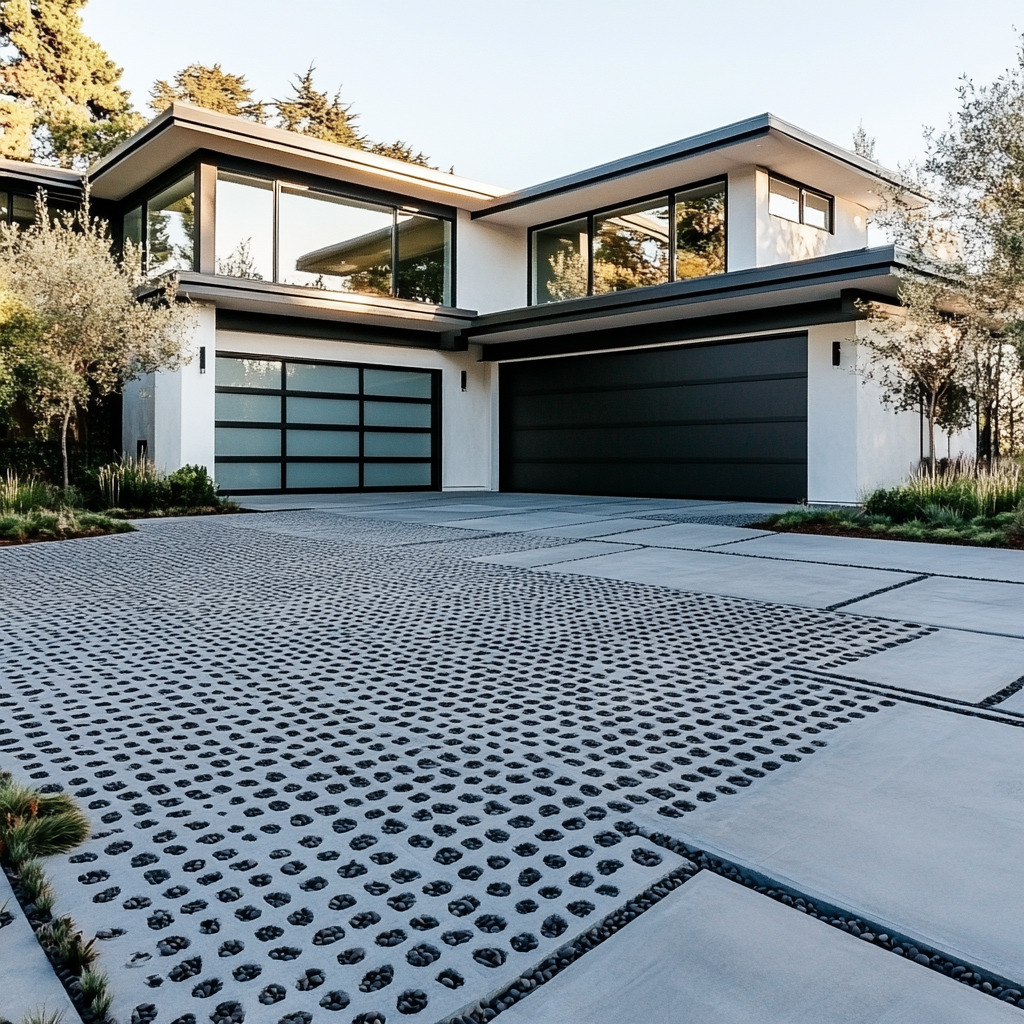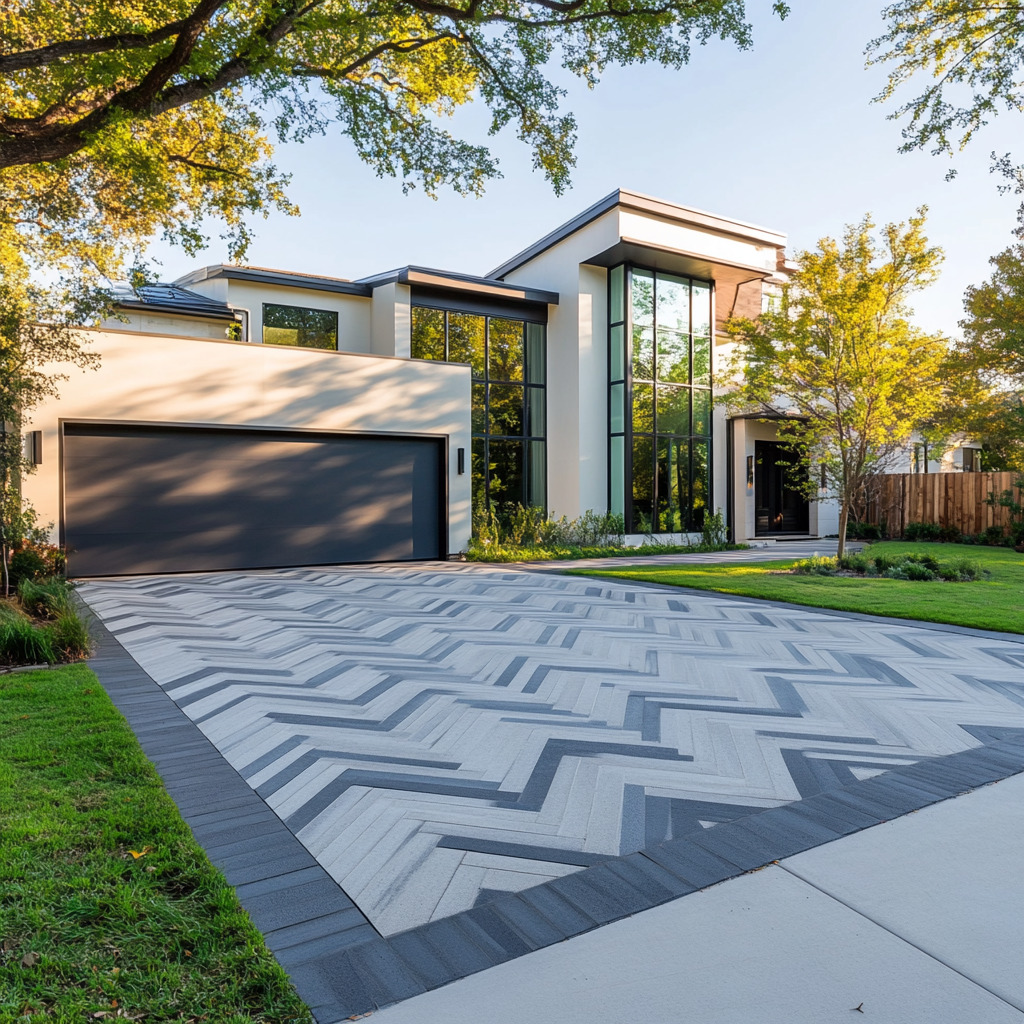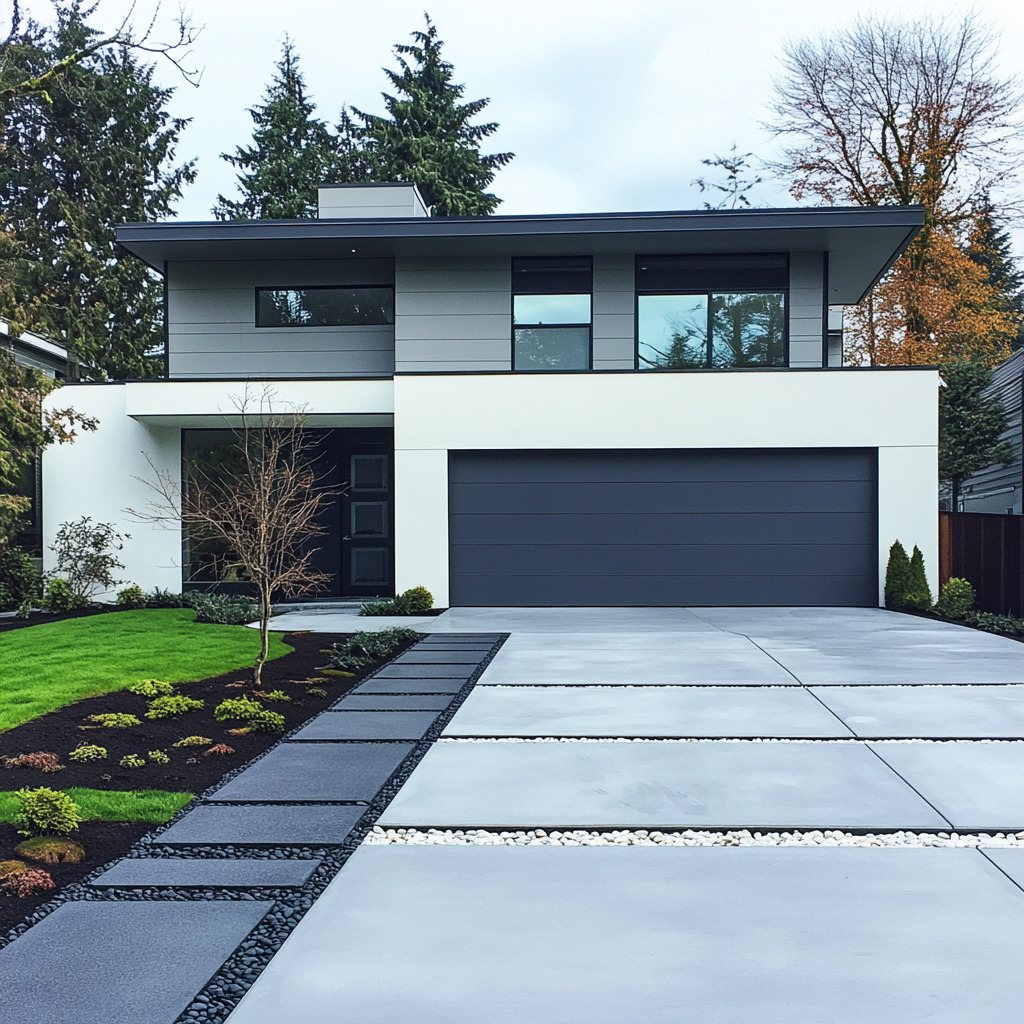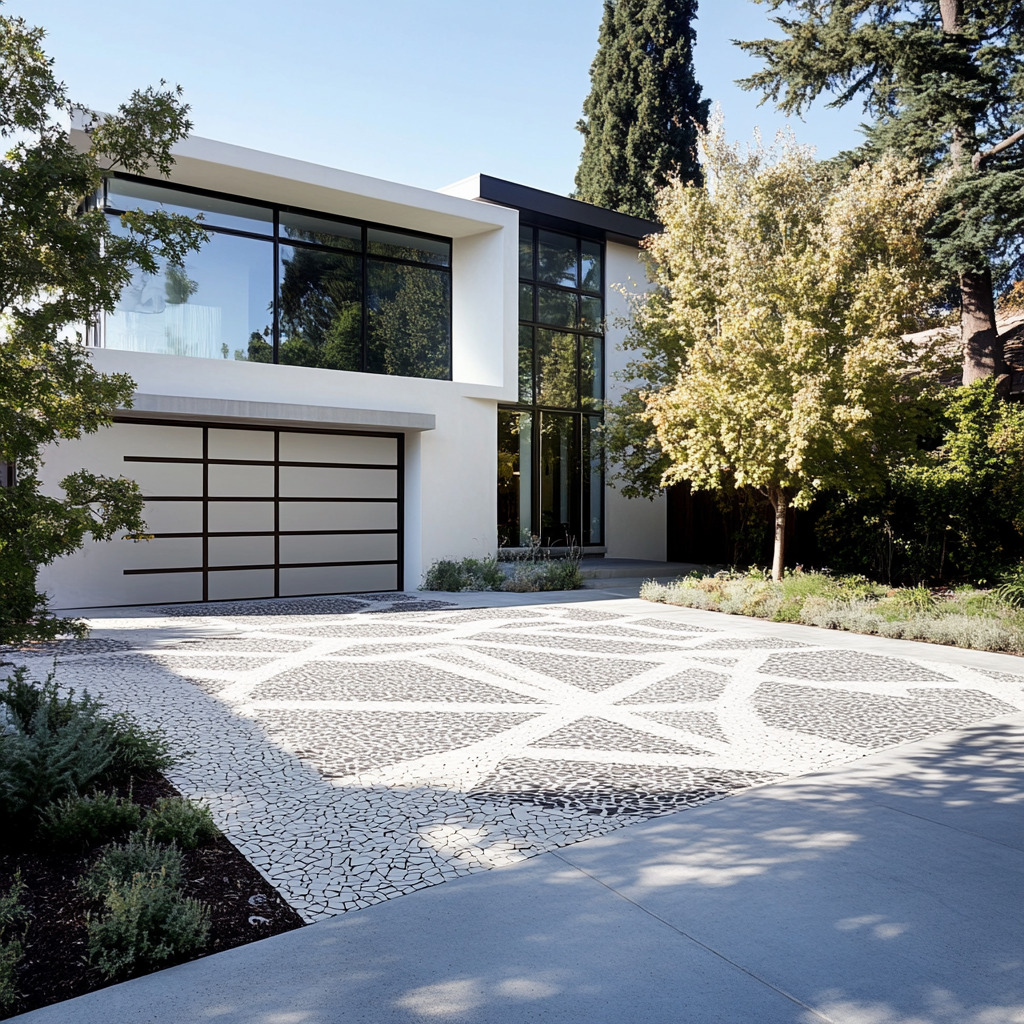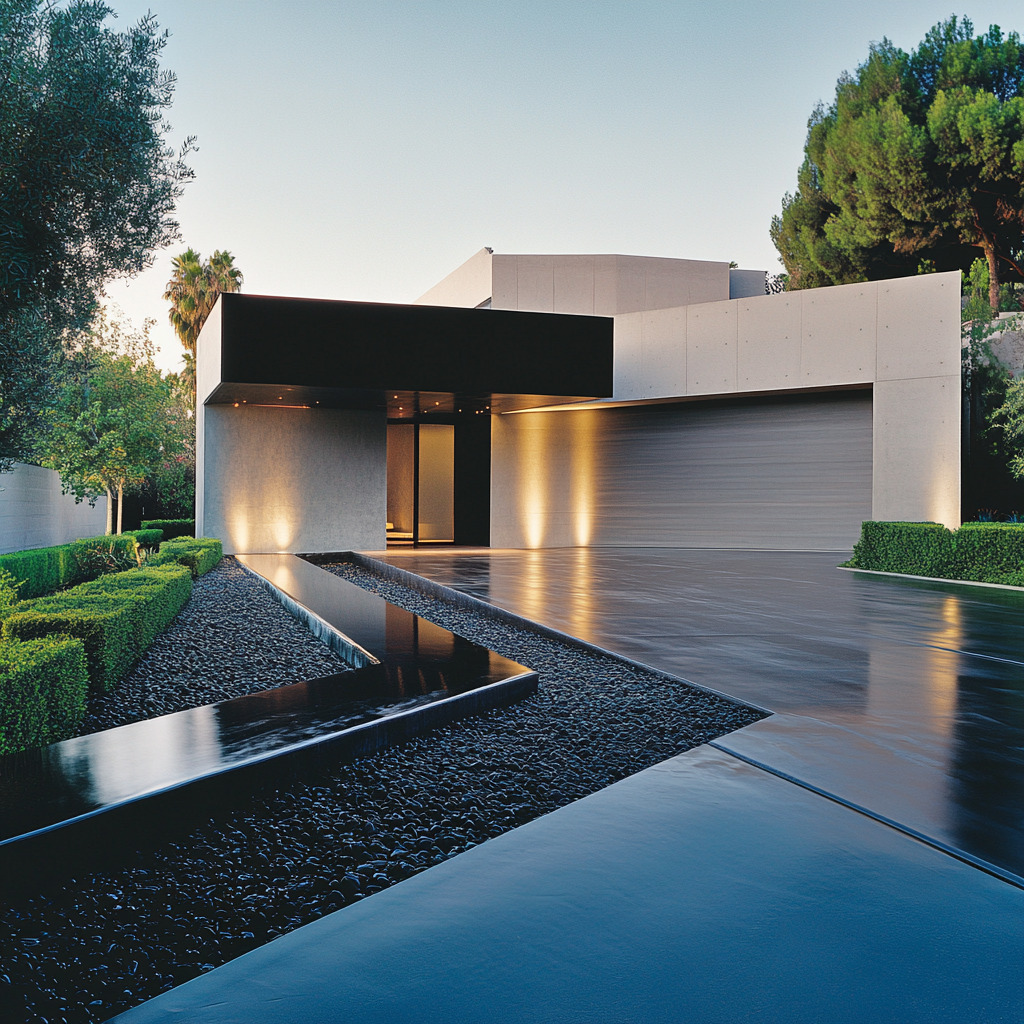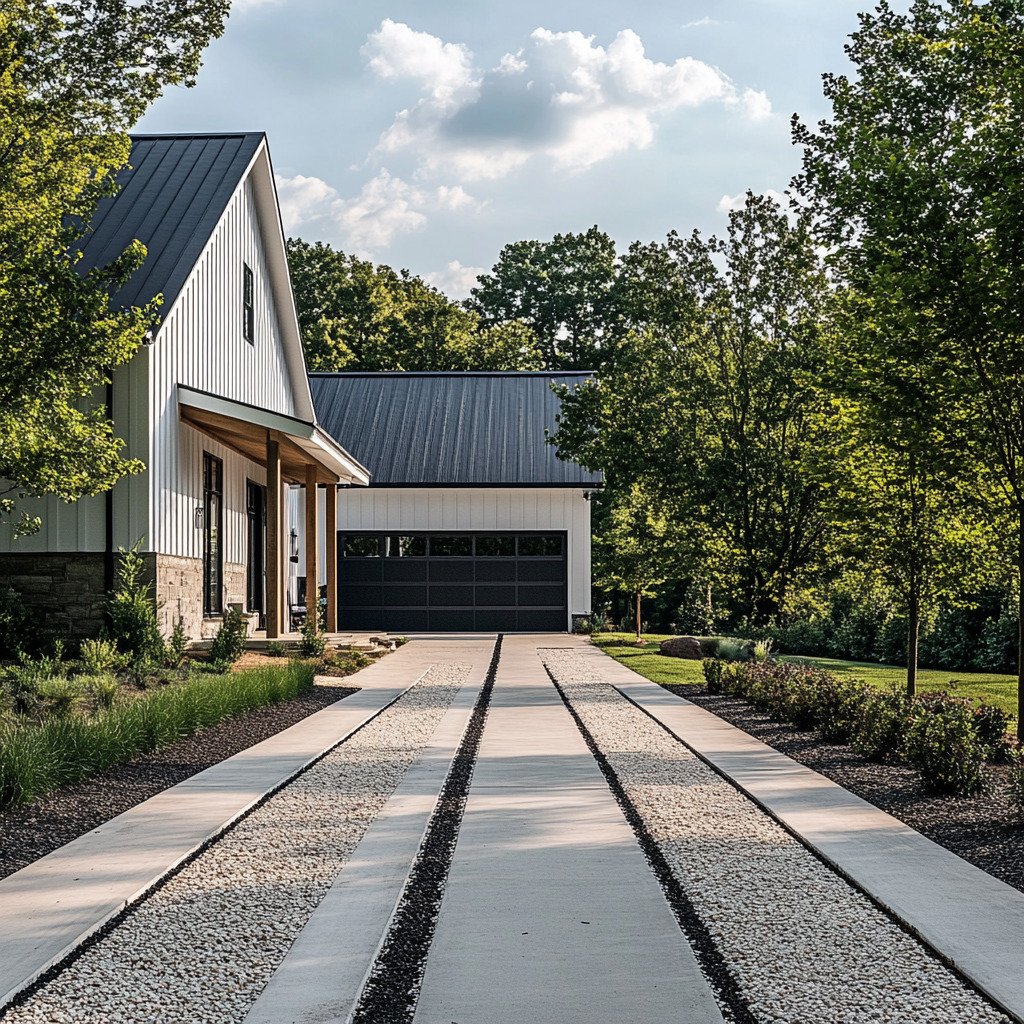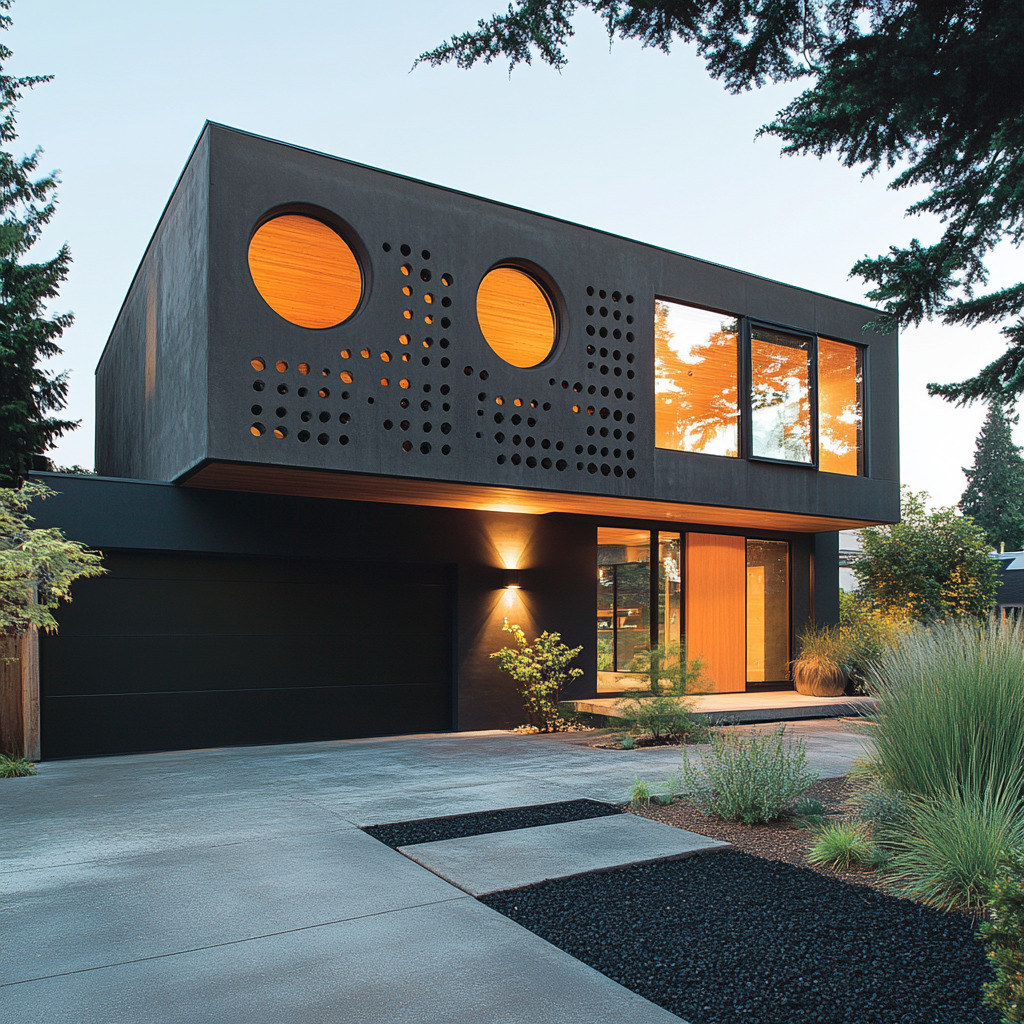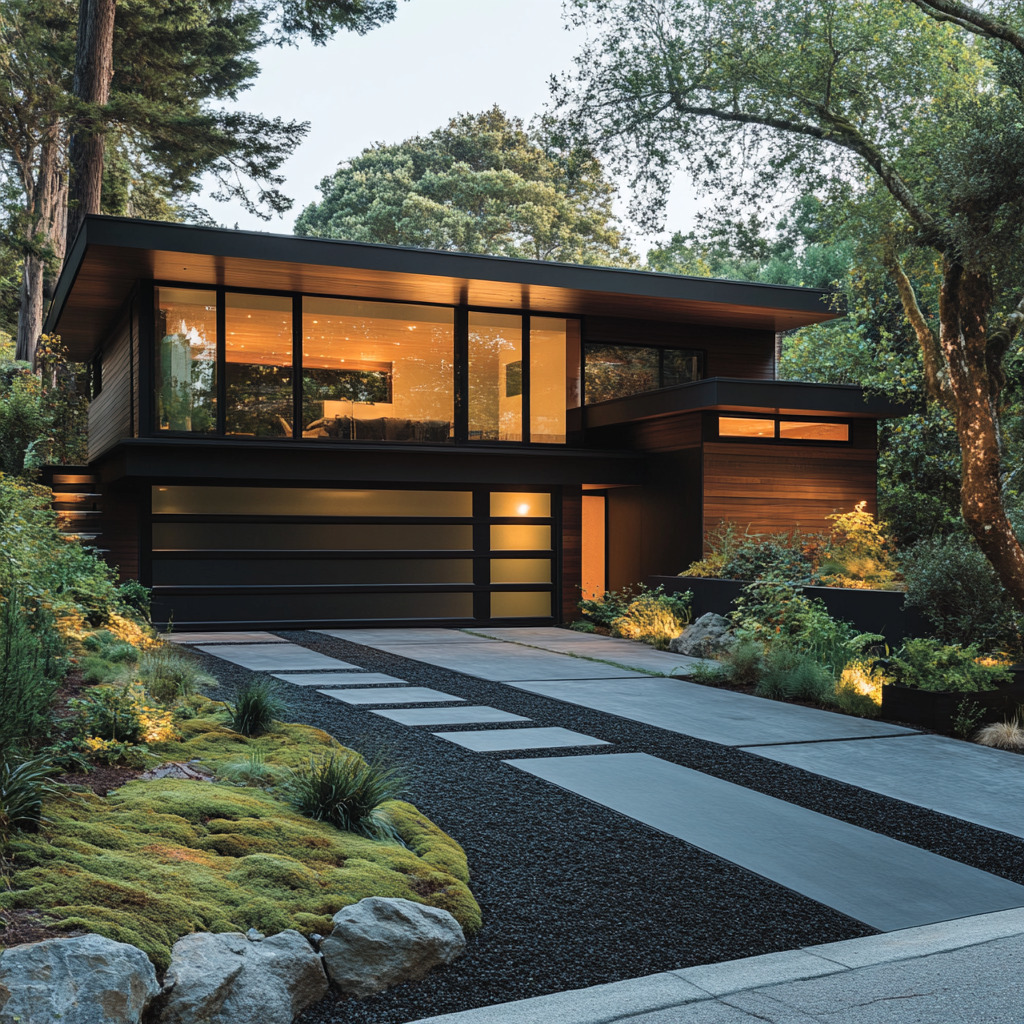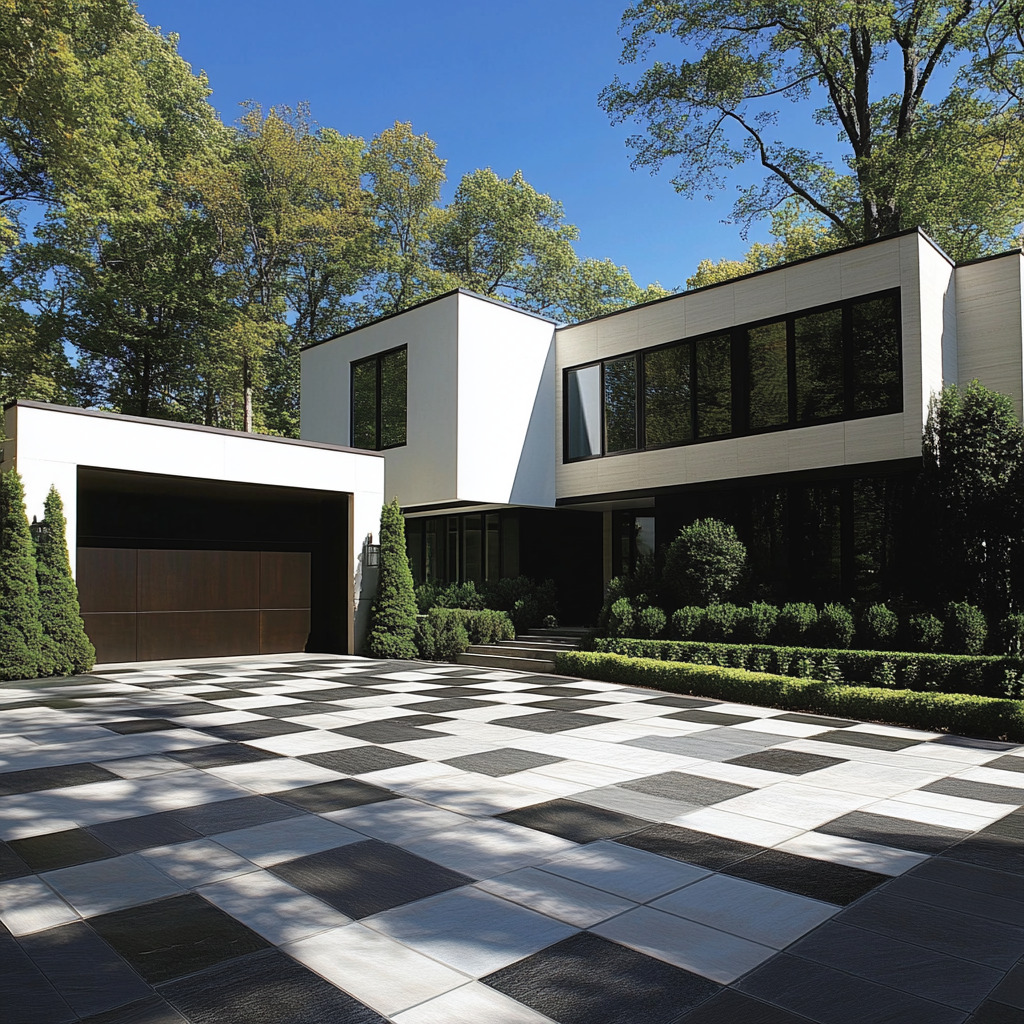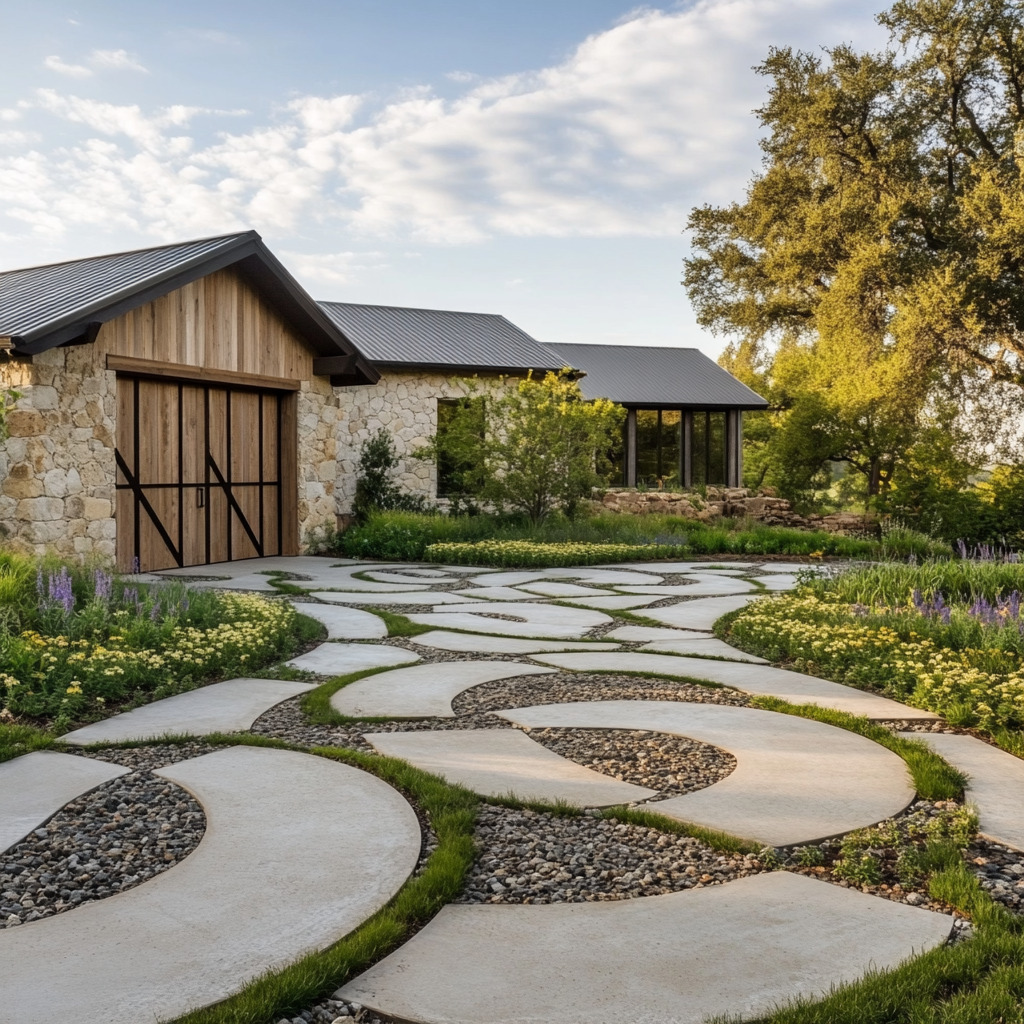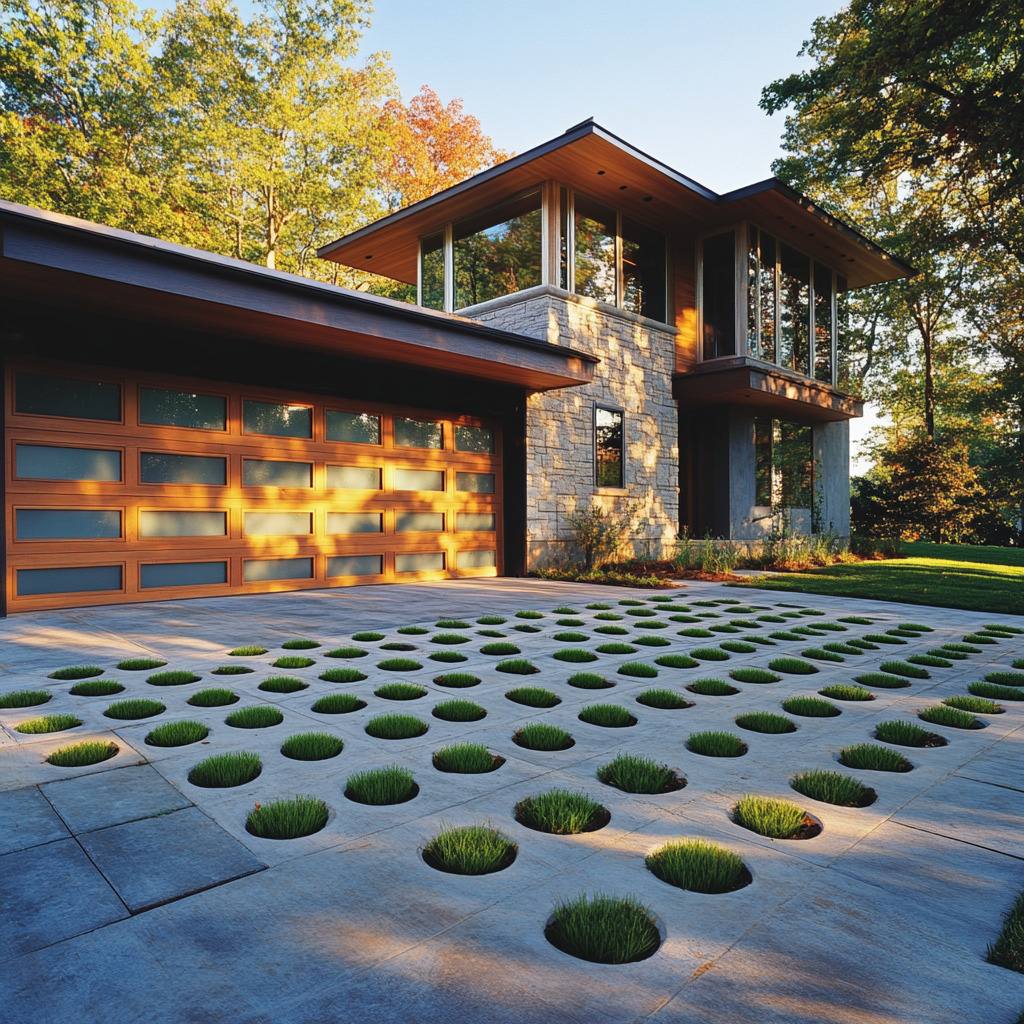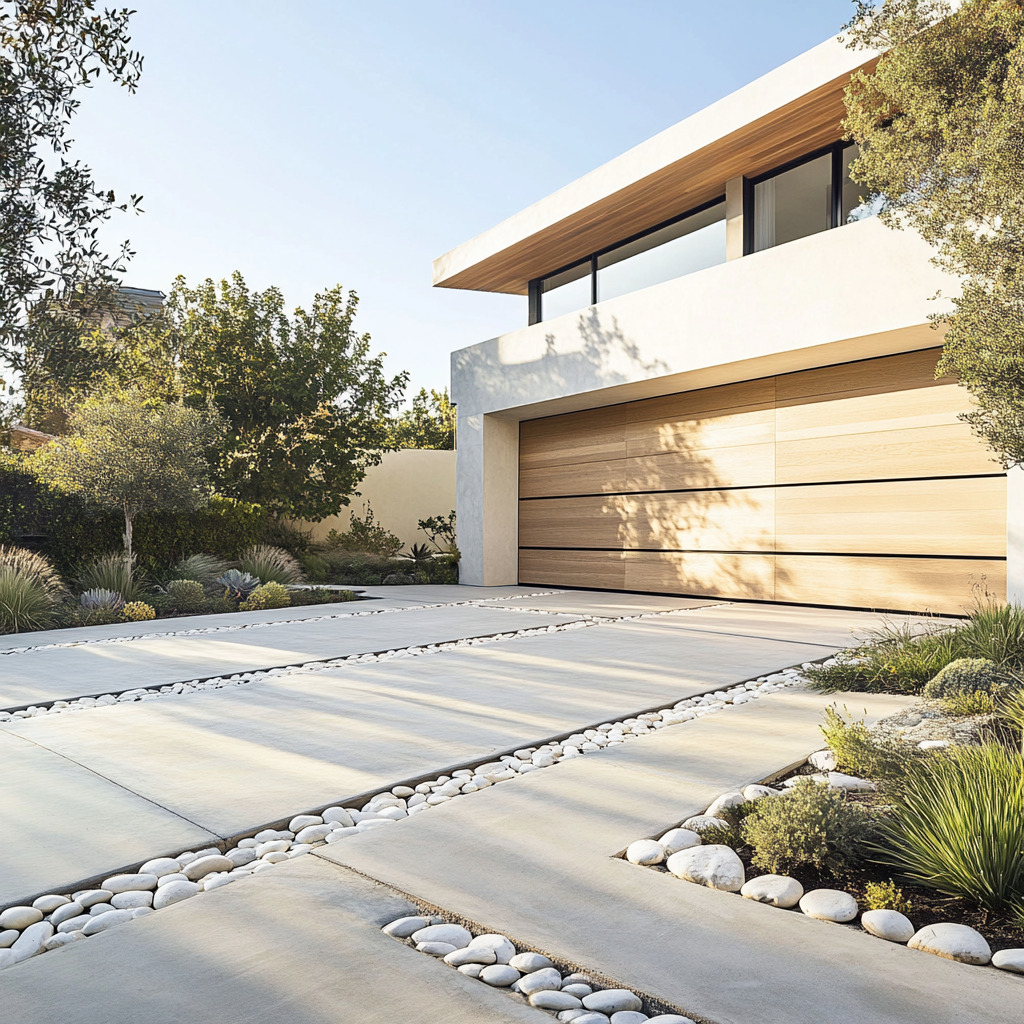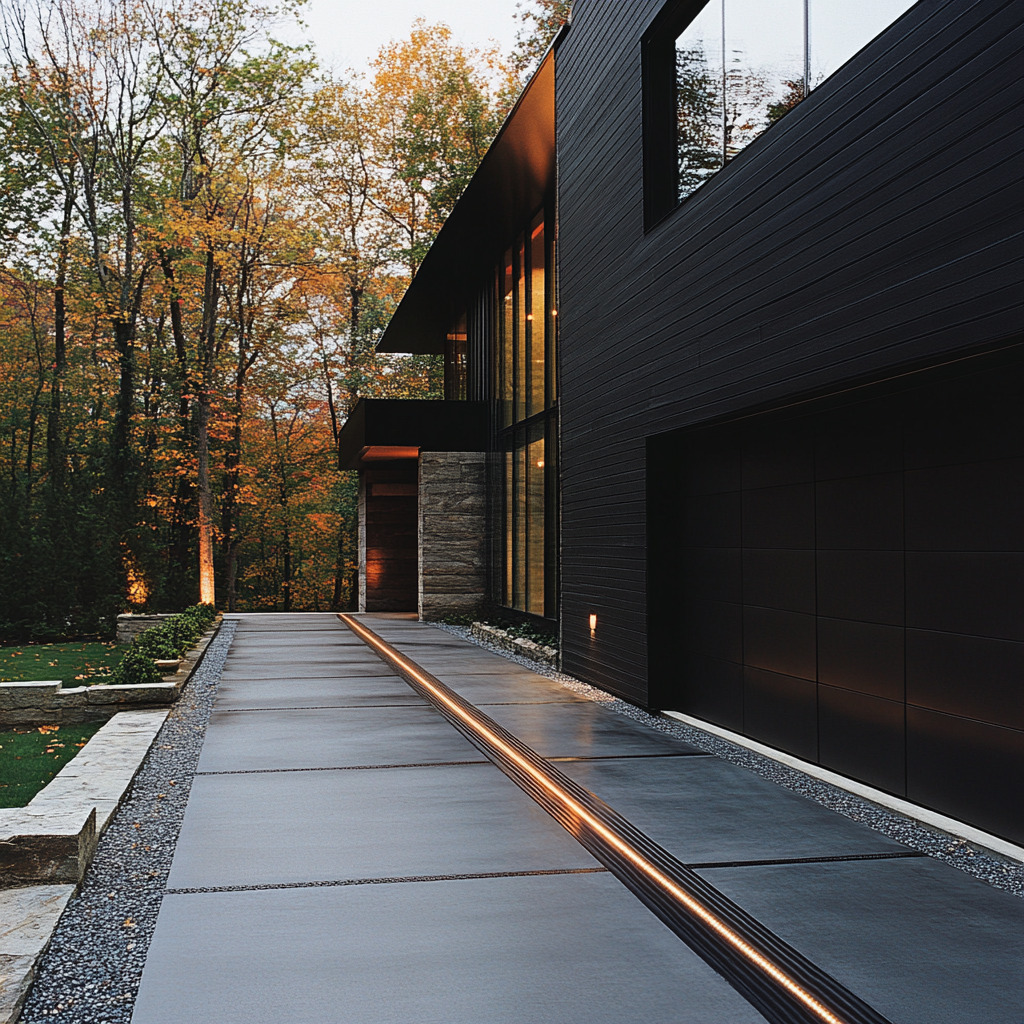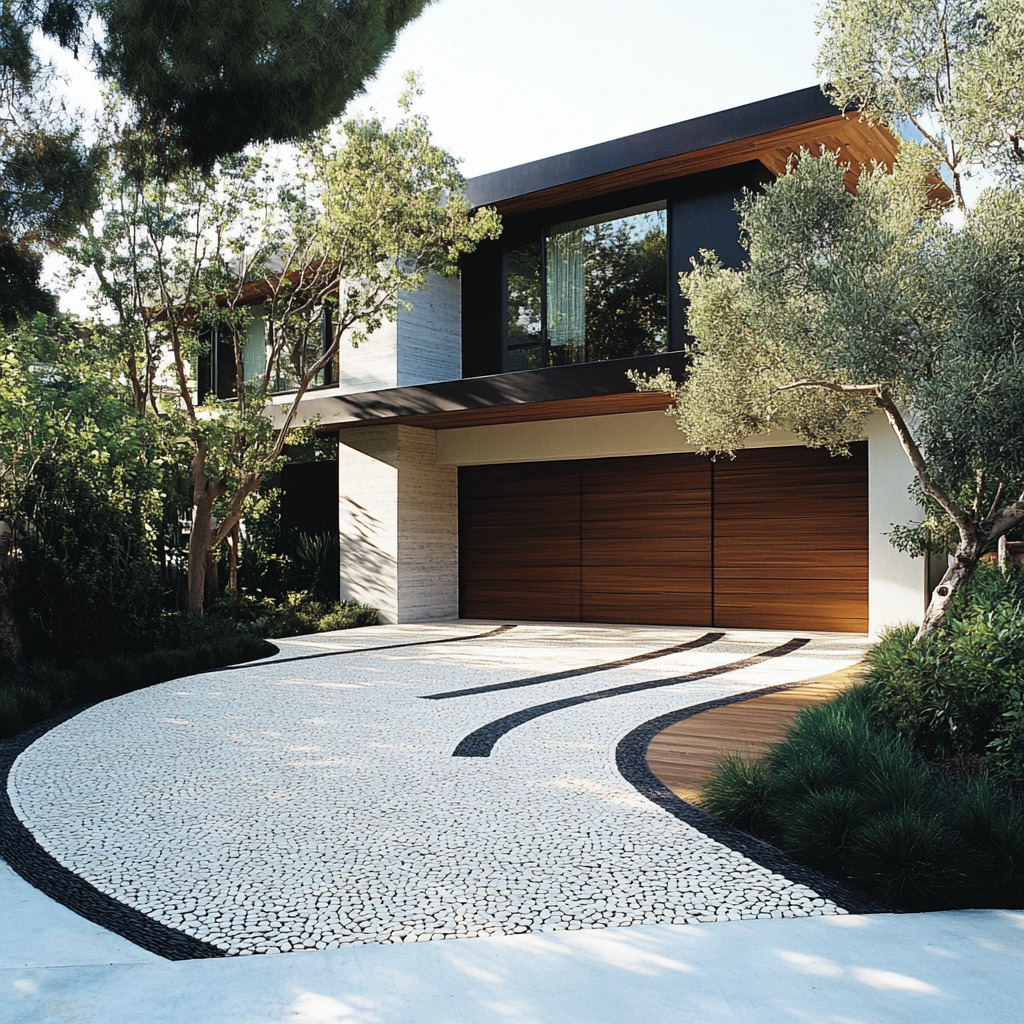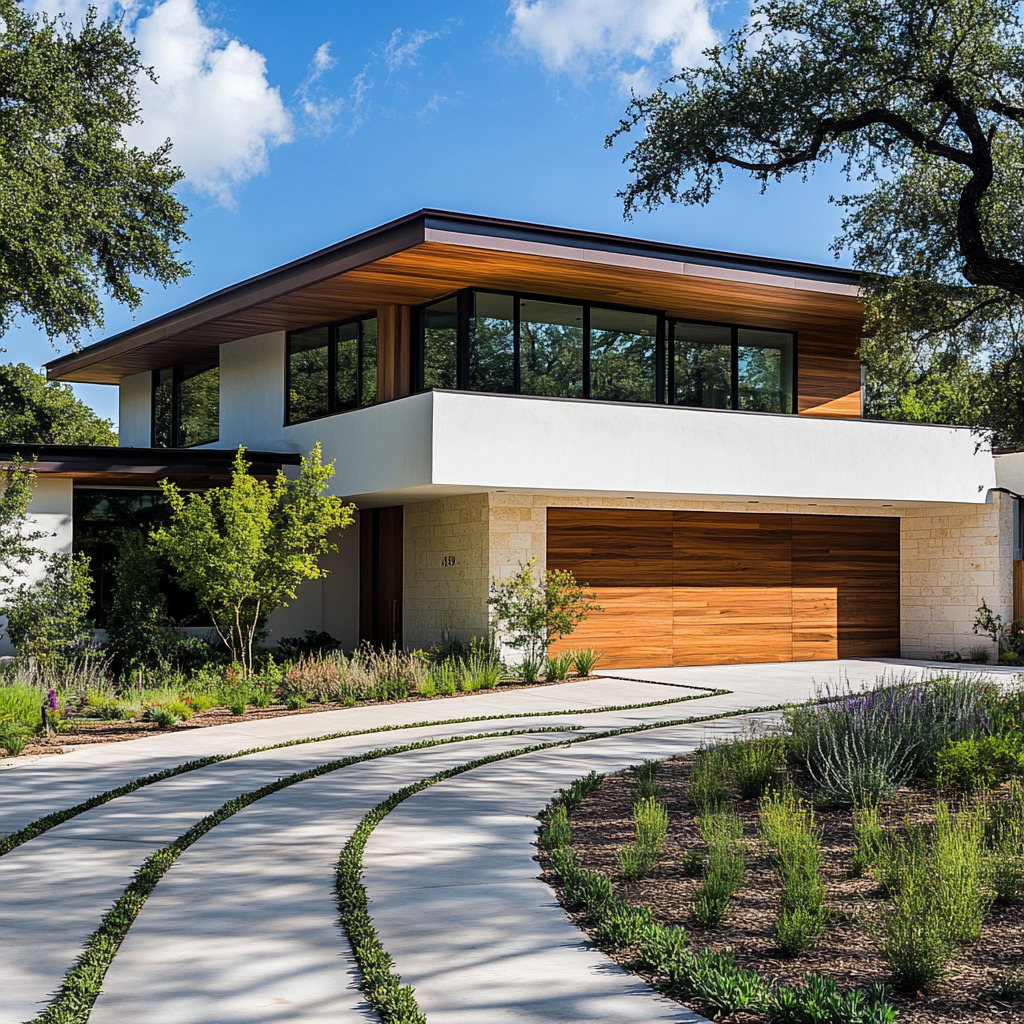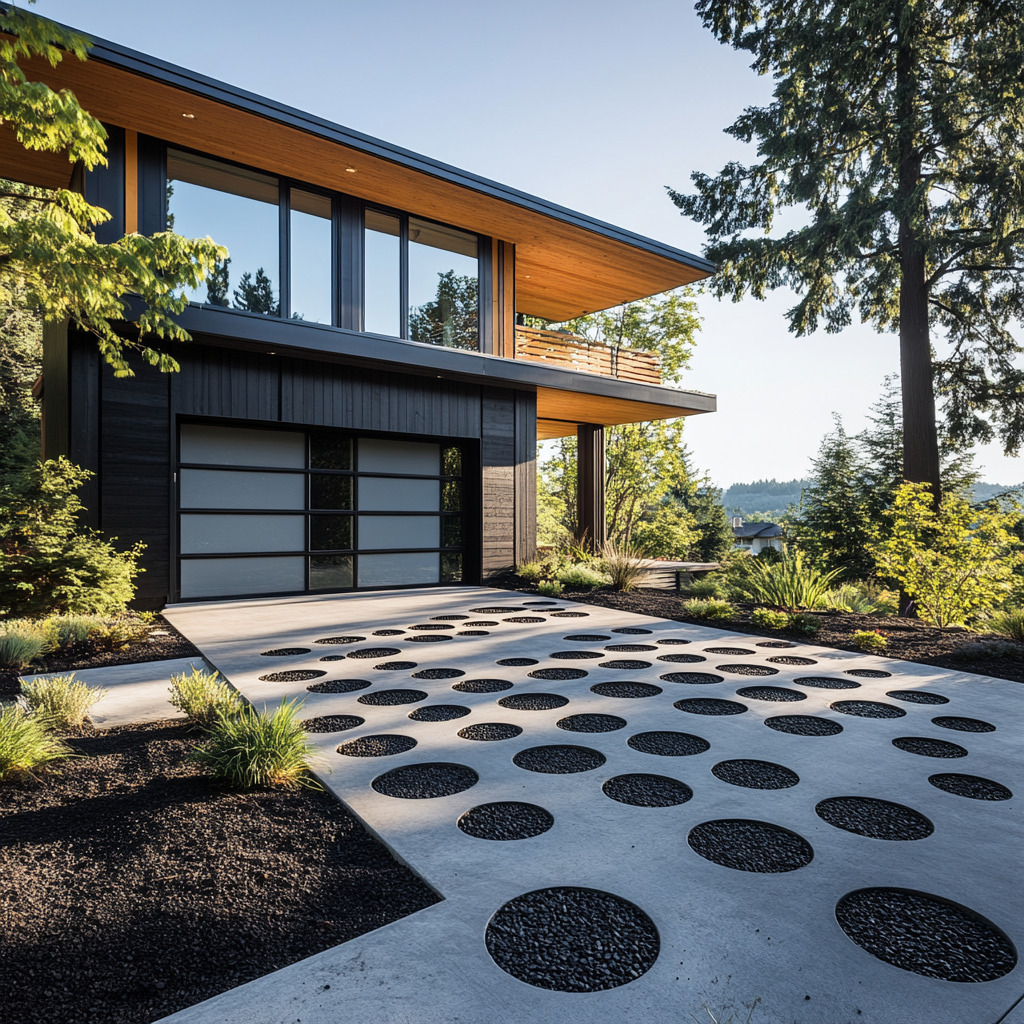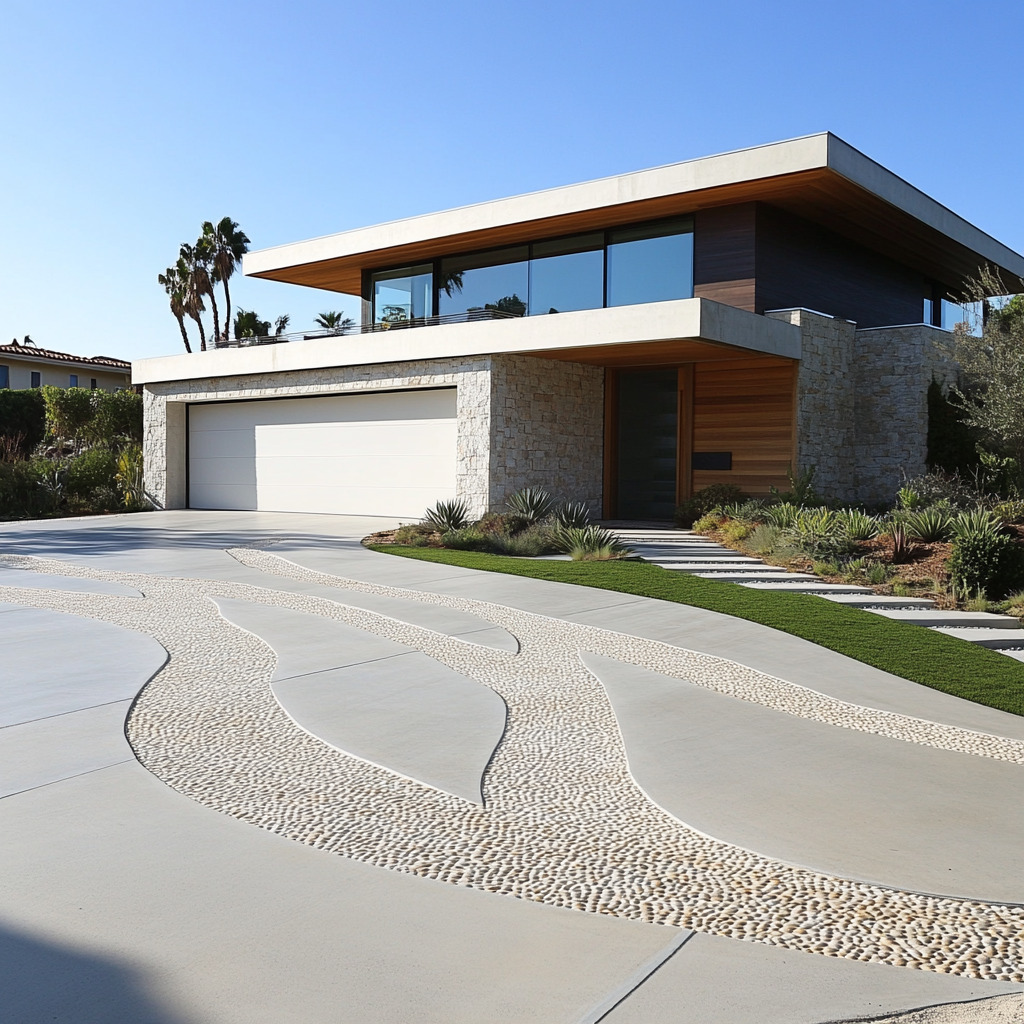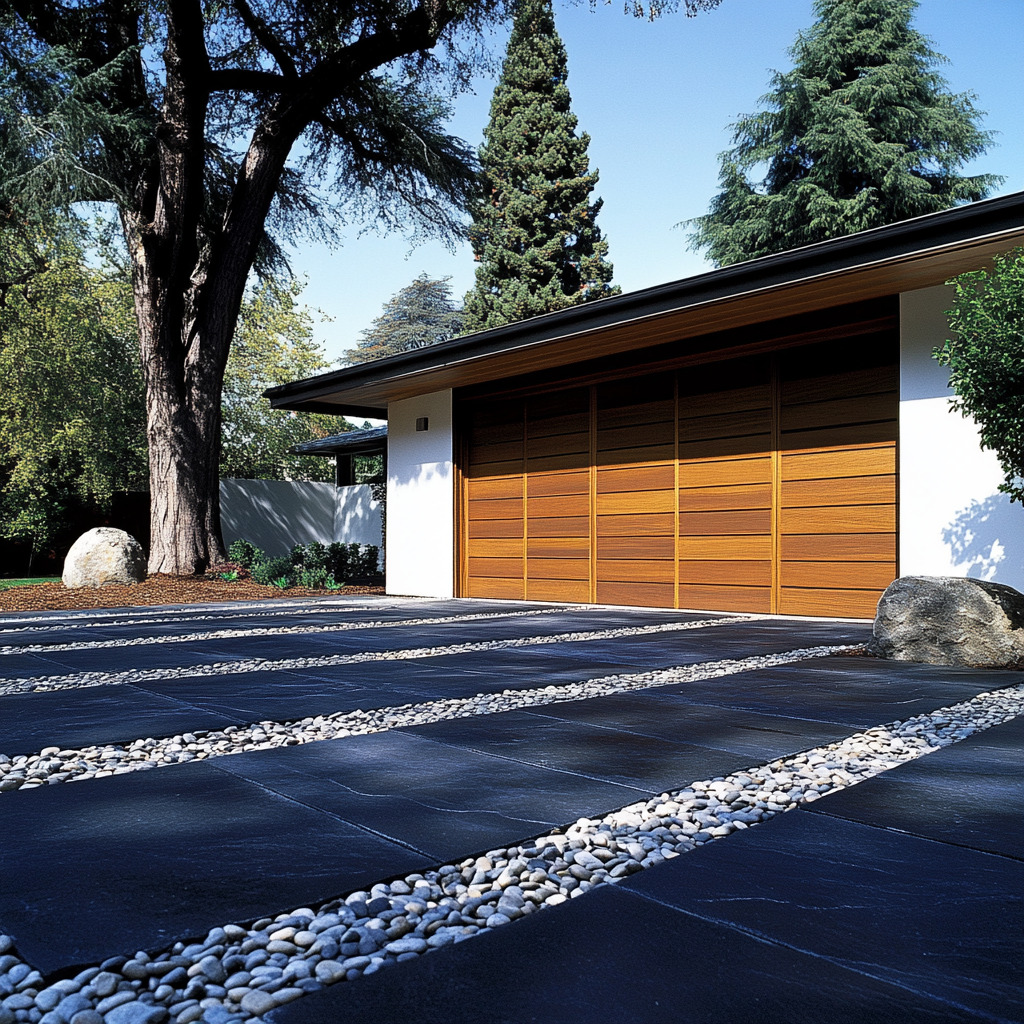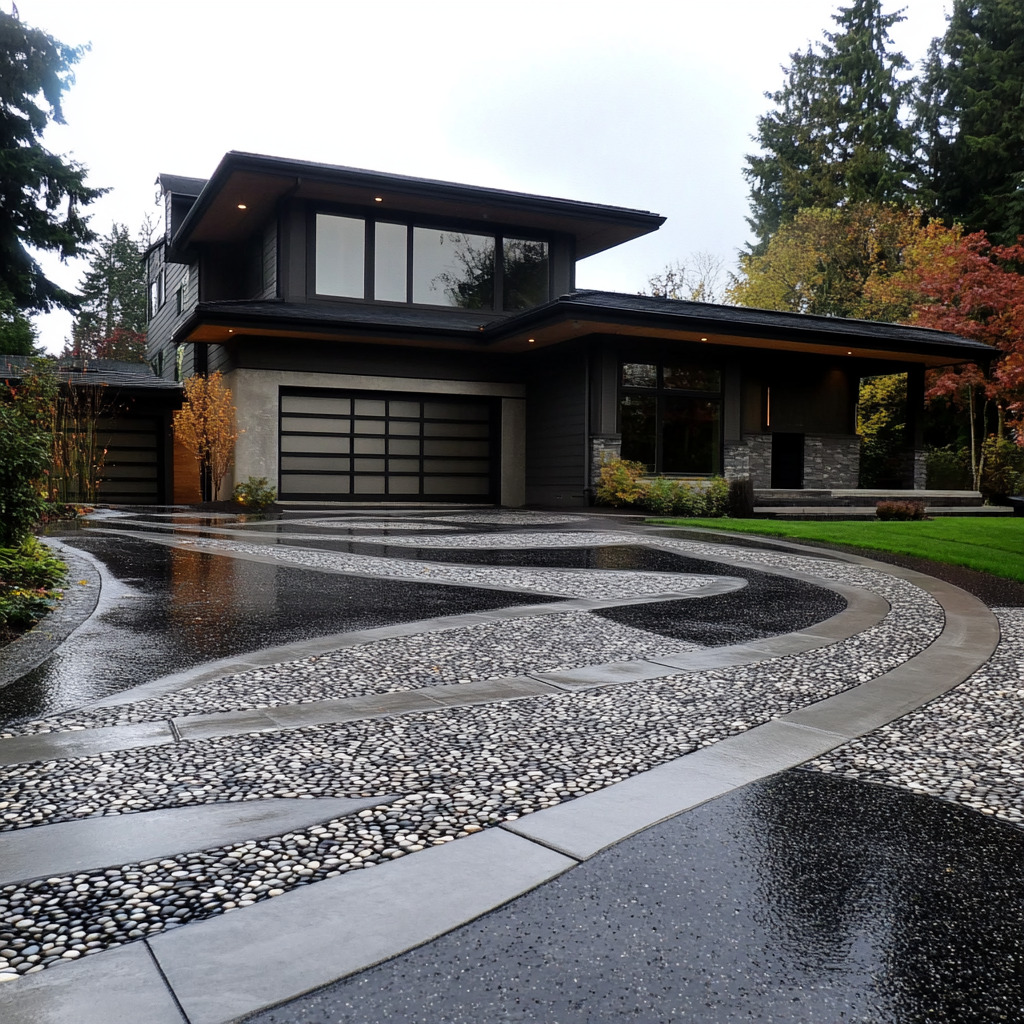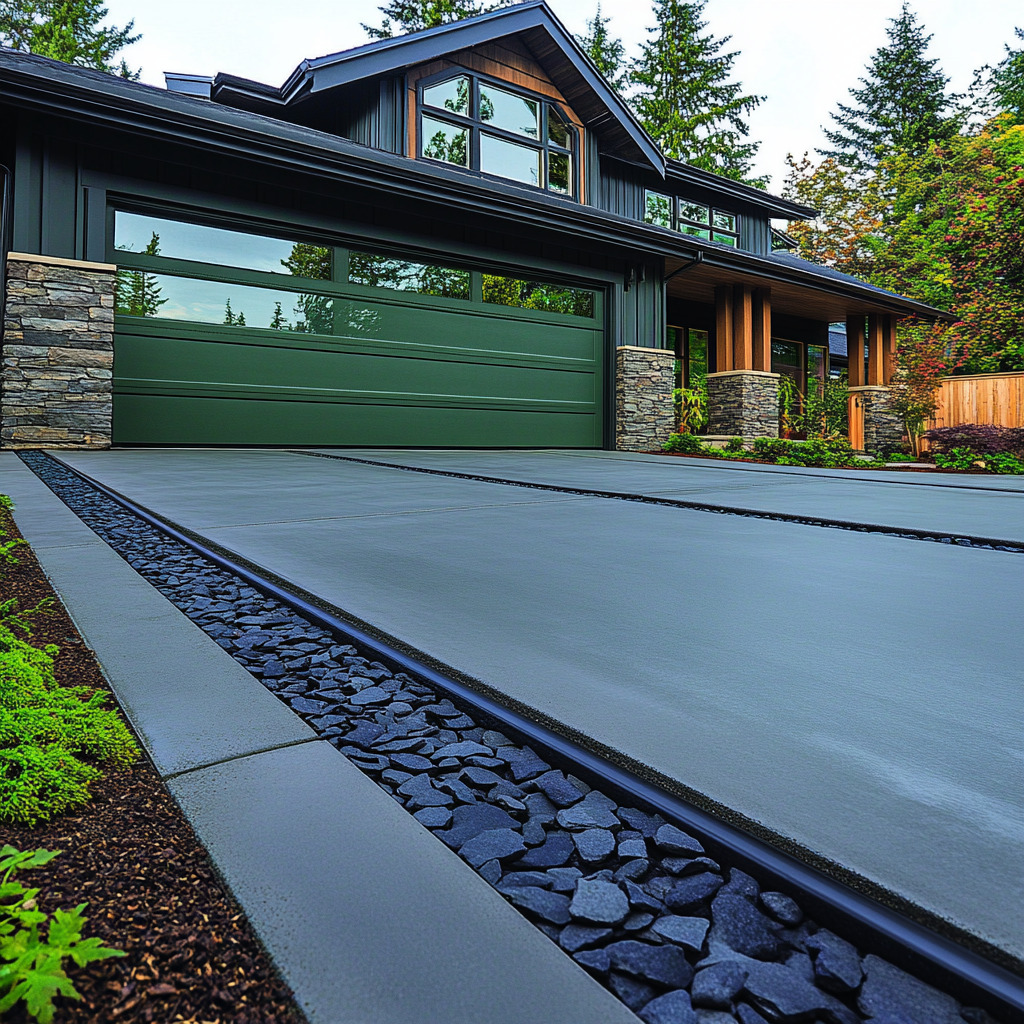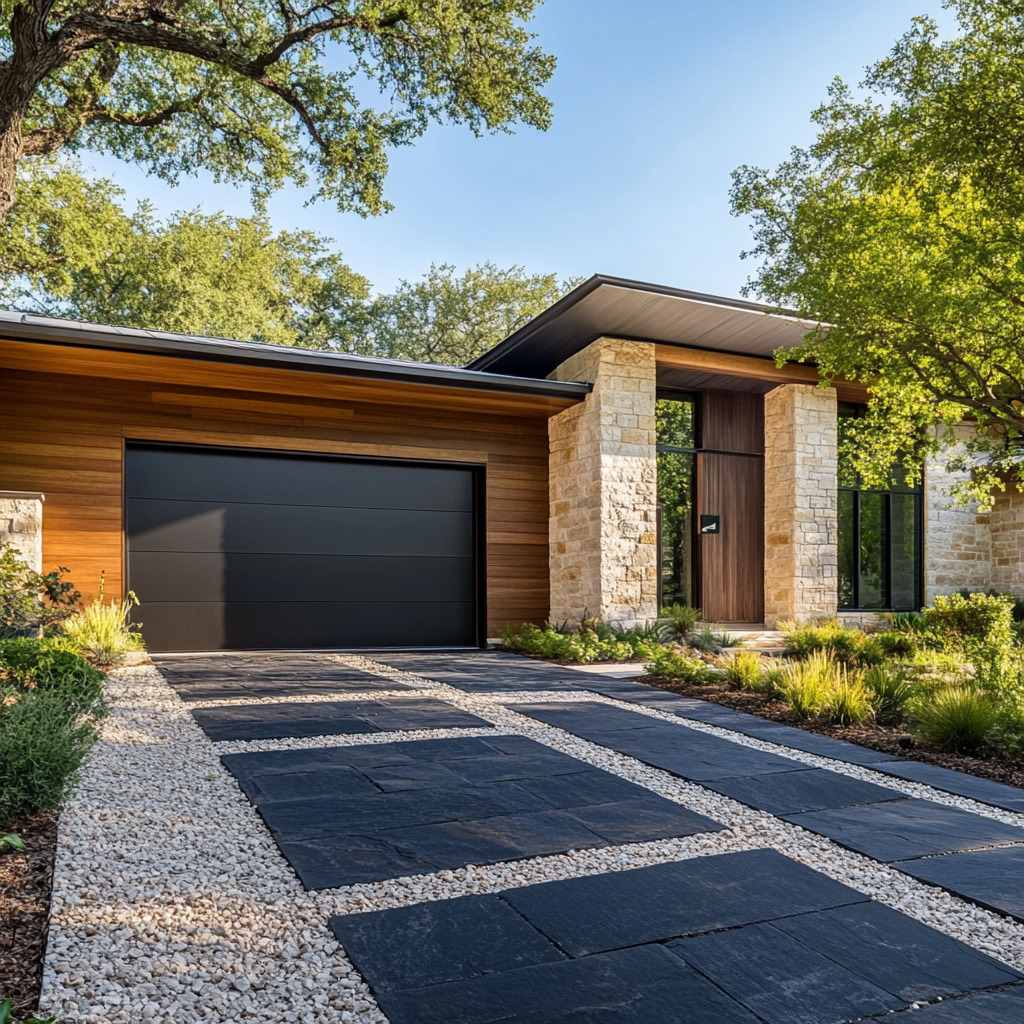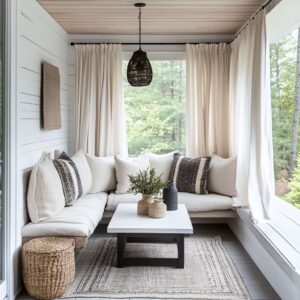Today’s driveway design ideas are no longer limited to plain concrete slabs leading to a garage. What we’re seeing instead is an approach where the driveway becomes an extension of the home itself.
Carefully planned layouts, thoughtful materials, and precise lines turn these spaces into something far more considered and impactful than a simple parking space. Below, we break down the less obvious, but highly intentional strategies that set these designs apart.
Driveways as Architectural Extensions, Not Separate Elements
One of the most interesting observations in modern driveway design is how seamlessly these surfaces connect with the house. Instead of feeling like a separate zone, they carry the lines, materials, and mood of the architecture right into the front yard.
It’s an approach you’ll find frequently in contemporary homes across suburban neighborhoods, especially where the focus is on minimalism or clean design.
Horizontal Alignment Precision
A driveway might seem like an independent element, but many designers are aligning its layout with architectural features like window mullions, garage door slats, and roof edges. This precision might fly under the radar for most people, but it has a powerful effect on the overall look.
Whether it’s the rhythm of the concrete slab joints or the direction of pebble inlays, these lines often mirror the structure of the home itself. This is no accident.
It’s a subtle way to keep the eye moving naturally from the driveway to the house, creating a sense of connection without any visual breaks.
Material Echoing
This strategy takes things a step further. Rather than introducing a random mix of textures or colors, many front driveway ideas pick up where the house facade leaves off.
If the house uses limestone cladding, you might find limestone gravel bands between concrete slabs. If the home’s exterior features polished wood or metal, there’s a good chance the driveway surfaces reflect the same finish.
The trick is not in simply matching materials but in ensuring they speak the same visual language. A smooth concrete driveway, for example, might echo the brushed finish of steel window frames.
Subtle, but highly effective.
Controlled Contrast: Geometry vs. Organic Flow
Great driveway design ideas often strike a delicate balance between order and movement. Especially in modern homes, where clean lines and boxy shapes dominate, adding curves or irregular patterns can prevent things from feeling too rigid.
It’s a technique that’s widely used in regions known for contemporary design aesthetics, like California and parts of the Southwest.
Soft Curves Taming Sharp Architecture
When a house presents a strict geometric face—flat roofs, sharp corners, large window panels—the driveway has an opportunity to soften that impression. You’ll often see curved stone inlays or pebble mosaics that move gently across the driveway, breaking up the severity of an otherwise sharp layout.
These aren’t decorative flourishes. They guide cars and people toward the house at a slower, more intentional pace.
Instead of rushing into a garage, the approach feels calm, measured, and welcoming.
Curvature and Movement as Orientation Tools
Another smart use of curved elements in gravel driveway ideas is their role in directing traffic, both vehicular and pedestrian. Curved bands of contrasting pebbles or stone inlays act like visual lanes without the need for barriers or curbs.
They create a natural path that cars follow without a second thought. It’s a quiet design move that enhances both function and aesthetics, letting people move through the space with ease and without confusion.
Height Variation and Depth Play for Subtle Complexity
One of the least obvious but most sophisticated strategies in modern driveway design is the subtle manipulation of height and depth. It’s a way to introduce texture and interest without compromising the surface’s usability.
And while these details might escape notice at first glance, they add a richness and quality that make the space feel thoughtfully finished.
Recessed Inlays (Less Than ½ Inch)
Many driveways now incorporate recessed channels that hold gravel, pebbles, or stone. While the difference in elevation might be less than half an inch, it’s enough to cast fine shadow lines that add depth to the surface.
This small detail makes large concrete slabs appear less monolithic and introduces rhythm across the surface. These recesses also serve a practical purpose, helping with water drainage and keeping the pebbles contained.
Slightly Raised or Lowered Stone Channels
This same technique is used in stone channels that run between slabs or along the driveway’s edge. Whether slightly sunken or just proud of the surface, these channels double as drainage paths, carrying rainwater away without the need for visible grates or hardware.
In many high-end designs, especially those inspired by Scandinavian or Japanese minimalism, this level of craftsmanship is what sets the driveway apart. The channels also offer expansion space for the concrete slabs, reducing the risk of cracking over time.
Driveways as Environmental Moderators
An unexpected but highly impactful approach in modern driveway design is the way these surfaces contribute to environmental comfort. Far from being static slabs, today’s driveways are often engineered to improve temperature control, manage water flow, and even support microclimates around the home.
While most people focus on appearance, these subtle functional elements play an equally important role in how a driveway performs.
Heat Island Mitigation Through Material Choice
Many cement driveway designs take advantage of light-colored finishes and pale stone aggregates to reduce surface temperatures. Pale concrete and white or cream-toned pebbles absorb less heat during the day, helping to keep the immediate surroundings cooler.
This is especially valuable in warmer climates, where traditional dark paving materials can intensify heat buildup. Beyond color, the integration of gravel sections or grass strips between slabs provides natural cooling through evapotranspiration, creating a softer, more breathable surface underfoot and under tire.
Water Management Without Visible Infrastructure
Instead of relying on obvious drains or grates, many driveways now include clever, almost invisible solutions for water control. Recessed gravel channels, often filled with crushed stone or basalt chips, quietly direct rainwater away from the surface.
Some contemporary driveway ideas also use grass plug inserts, which act like mini catch basins. These small planted areas improve rainwater infiltration into the soil, reducing runoff while adding a touch of green texture.
It’s a seamless way to blend sustainability with visual appeal.
Passive Cooling and Airflow via Water Features
In some high-end designs, you’ll even find water features running alongside the driveway. These aren’t simply decorative pools; they actively help to cool the surrounding hardscape by lowering the temperature of passing air.
Whether it’s a reflecting pool or a narrow runnel of water, these elements create a subtle microclimate that benefits the entire entry area without any need for powered systems.
The Driveway as a Transitional Space (Threshold Design)
Beyond function and form, a well-planned driveway has the power to shape how a visitor experiences the approach to a home. These are no longer just areas to park cars—they’re spaces that mark the passage from public to private, from street to sanctuary.
This concept of threshold design has become a defining feature of modern driveways.
Slowing the Arrival
One clever tactic designers use is shaping the driveway to slow down the pace as a vehicle nears the house. Curved pathways, patterns made from alternating pavers, or ground cover strips between concrete tracks subtly encourage drivers to ease up on speed.
The effect creates a gradual, intentional arrival, similar to a ceremonial approach. This technique works especially well in homes influenced by Mediterranean and Japanese design, where slowing down becomes part of the experience.
Wayfinding Without Borders
Another strategy seen in thoughtful contemporary driveway ideas is the use of contrasting materials to direct movement. Light and dark stone, smooth concrete against textured gravel, or bold banding along the edges all help to guide drivers and pedestrians without the need for physical barriers.
These subtle cues make it clear where to go and how to move through the space, while keeping the area open and uncluttered. It’s a quiet form of direction that works on instinct rather than instruction.
Lighting and Shadows as Sculptural Elements
Lighting is often overlooked in driveway design, but in the best examples, it plays a leading role. It’s not just about visibility at night—it’s about using light and shadow to bring depth and life to the hardscape.
Linear Lighting as a Navigational Aid and Design Feature
In many modern driveways, linear LED lighting is integrated directly into the paving. Whether recessed in metal channels between slabs or tucked along the edge of a path, these lines of light help guide vehicles and people after dark.
But they’re also an architectural statement, emphasizing expansion joints, geometry, and the rhythm of the space. At dusk, they provide a soft glow that complements the home’s exterior lighting, making the entire scene feel cohesive.
Shadow Play Through Surface Texture
The textures used in surfaces like cleft slate, rough basalt cobbles, and perforated concrete do more than add grip—they catch and play with light throughout the day. As the sun shifts, these textures cast shadows that move slowly across the driveway, changing its appearance from hour to hour.
It’s a subtle but powerful effect that brings life to what could otherwise be a flat, static space. These shifting shadows also highlight craftsmanship in paving choices, bringing out the fine details in materials that often go unnoticed.
Fusion of Heritage and Modernity
Some of the most creative driveway pattern ideas blend time-honored traditions with sharp modern lines. Designers are borrowing classic concepts from historical landscapes and architecture, then updating them with contemporary materials and precision.
This mix results in driveways that feel both familiar and refreshingly current.
Ribbon Driveways with a Modern Twist
The ribbon driveway, once a practical solution to minimize paved areas, is making a comeback in a far more refined form. Originally designed to leave grass growing between tracks for water absorption, today’s interpretations feature clean concrete ribbons with crisp edges, paired with carefully contained gravel beds.
This approach is popular in areas where sustainable landscaping is valued, offering both reduced surface heat and better drainage without giving up on aesthetics.
Japanese Zen Garden Influences Brought Forward
In many homes that take cues from Japanese minimalism, the driveway reflects similar principles. Curving bands of cobblestones or raked gravel mimic the quiet simplicity of Zen garden layouts.
But instead of loose gravel or freeform paths, these designs incorporate precise layouts and structured planting. Neatly arranged grasses or small shrubs frame the driveway edges, echoing the quiet discipline of traditional Japanese gardens while keeping things suitable for a modern home.
Basket Weave and Checkerboard Patterns with a Contemporary Edge
Patterns long used in classic masonry—like basket weave or checkerboard—are being scaled up for modern use. Larger concrete slabs or stone tiles replace the small bricks of the past, creating bold geometric layouts that stand out from a distance.
Checkerboard designs, in particular, bring a sense of balance and rhythm to wide driveway surfaces, often pairing light limestone with dark granite for maximum contrast. These bold patterns feel crisp and modern while nodding to traditional craftsmanship.
Imperfection as a Luxury
In a world of laser-straight lines and flawless surfaces, there’s something special about embracing nature’s own irregularities. Some of the most striking driveways achieve their beauty by letting stone and texture speak for themselves—without forcing everything into perfect uniformity.
Natural Irregularity in Stone
Whether it’s rust-colored streaks running through slate or the subtle shift in shades of pebble inlays, these ‘imperfections’ are often the key to a driveway’s charm. Rather than aiming for uniform color or texture, designers are choosing materials that offer variation.
This makes the space feel more organic, even in highly structured designs. The contrast between carefully aligned slabs and naturally varied materials keeps things interesting, offering layers of depth that you only notice on closer inspection.
Handcrafted Sensibility with a Refined Approach
Driveways featuring layouts like radial cobblestone starbursts or hand-laid mosaics give a sense of artisan craftsmanship, even when the rest of the home leans modern. These are designs that require precision and a steady hand to avoid looking messy—but when done right, they elevate the entire space.
It’s a quiet kind of luxury, one that values the marks of human skill over machine-perfect symmetry. The slight irregularities in spacing, or the natural texture of each stone, make these driveways feel authentic and timeless.
Sustainability Beyond Plant Choice
Sustainable driveway design has moved far beyond the simple inclusion of drought-tolerant plants. Many of today’s most thoughtful driveways incorporate strategies that consider water management, material sourcing, and environmental impact from the ground up.
These methods are subtle but highly effective, often blending seamlessly into the overall look without drawing attention to their function.
Permeable Paving
One of the most effective tools for managing runoff is permeable paving. Driveways that use grass plug holes, gravel infill between pavers, or stone-filled joints allow rainwater to soak directly into the ground.
This reduces surface water runoff and eases pressure on local stormwater systems. These designs often feature a mix of hard and soft surfaces, breaking up the expanse of solid pavement.
You’ll frequently see this approach in areas that prioritize low-impact landscaping, where function is integrated without compromising visual appeal.
Reduced Material Footprint
Some of the smartest driveway pattern ideas use only as much material as necessary. Ribbon driveways and strip driveways, for example, use narrower bands of concrete, which significantly lowers the volume of hard paving.
These strips are often paired with gravel or planted spaces in between, reducing the amount of cement used and lowering the carbon footprint. It’s a simple design choice that cuts back on materials while also adding interest and variety to the layout.
Recycled and Repurposed Materials
Another layer of sustainability comes from sourcing materials locally or using recycled content. Many driveways incorporate basalt or limestone gravel, which is often quarried nearby, minimizing transportation emissions.
In some cases, repurposed stone or reclaimed concrete is used for infill or edging, quietly contributing to an eco-friendly approach. These materials are chosen not only for their function and appearance but also for their reduced environmental impact.
Conclusions: What Sets These Driveways Apart
The driveways highlighted in this article represent a clear shift in how outdoor spaces are conceived. No longer treated as simple access routes, they’re now an essential part of a home’s design language, offering both function and visual interest.
Architectural Statements
Each driveway extends the language of the house into the landscape. The materials, patterns, and alignments are carefully planned to create a seamless connection between the building and its surroundings.
Whether it’s through strong geometric layouts or subtle curves, the driveway becomes part of the home’s identity.
Psychological Gateways
A driveway does more than guide a car to a garage. It frames the arrival experience.
Thoughtful layouts slow the pace, guide visitors intuitively, and create a sense of anticipation. It’s the first impression, and in many homes, it sets the tone for everything that follows.
Systems of Functionality
Beyond good looks, these driveways address real needs—handling drainage without visible infrastructure, marking pathways without barriers, and managing surface temperatures through material selection. It’s function delivered through design, where every decision has both purpose and aesthetic value.
Narratives of Materiality
Each material tells a story. Some reference traditional methods, like basket weave layouts inspired by historic masonry.
Others showcase modern innovations, like large-scale concrete slabs with integrated lighting. These choices aren’t random—they build a narrative that ties the home to its environment, history, and culture.
The best driveway designs are more than surfaces. They’re carefully considered spaces that blend architecture, landscape, and utility into a unified, meaningful experience.
